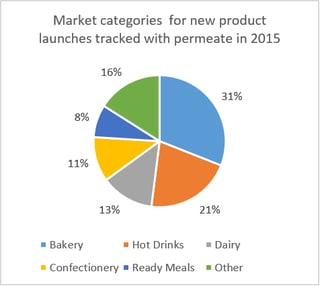-
A Stealthy Approach to Sodium Reduction
By Kara McDonald August 26, 2016- Tweet
 At this year’s IFT16 show, Elizabeth Crawford from FoodNavigator-USA visited the USDEC booth to find out what opportunities exist for manufacturers when formulating sodium-reduced products to preserve taste, save money on raw materials and increase consumer acceptance. The following are insights from our video discussion on reducing sodium with U.S. permeate.
At this year’s IFT16 show, Elizabeth Crawford from FoodNavigator-USA visited the USDEC booth to find out what opportunities exist for manufacturers when formulating sodium-reduced products to preserve taste, save money on raw materials and increase consumer acceptance. The following are insights from our video discussion on reducing sodium with U.S. permeate.The Stealthy Approach to Reducing Sodium
With encouragement from the U.S. Food and Drug Administration (FDA), food and beverage manufacturers are looking to new ingredients that mimic the taste and functionality of salt. The FDA advised manufacturers to voluntarily reduce the level of sodium in their products within the next two to 10 years after finding that most Americans consume more than 1.5 times the daily recommended intake.
Some may see this new voluntary guideline as a barrier, but there is definitely an opportunity to ease consumers into a healthier diet without them noticing. By taking a stealthy approach, slowly reducing sodium levels in products over two to 10 years, consumers are less likely to recognize the formulation difference. However, manufacturers still may hesitate in fear of losing good taste, but a reduction in sodium does not have to mean sacrificing flavor.
A Reliable Ingredient for Sodium Reduction
 U.S. dairy permeate can reduce sodium 50% to 70% in baked goods, soups and sauces, confections, dry mixes, meats and beverages. Permeate is a coproduct from the production of whey protein concentrate, ultra-filtered milk or milk protein concentrate. Permeate is partially known for its natural saltiness, which is why it is a unique sodium replacer that has been increasing in popularity for new product launches over the last decade.
U.S. dairy permeate can reduce sodium 50% to 70% in baked goods, soups and sauces, confections, dry mixes, meats and beverages. Permeate is a coproduct from the production of whey protein concentrate, ultra-filtered milk or milk protein concentrate. Permeate is partially known for its natural saltiness, which is why it is a unique sodium replacer that has been increasing in popularity for new product launches over the last decade.
The compound annual growth rate (CAGR) for permeate new product introductions was 39% from 2010 to 2015, according to Innova Market Insights. North America continues to lead in permeate new product introductions accounting for about 38% of new permeate-containing products tracked globally in 2015. Bakery remains the leading category for permeate, accounting for about 31% of the new permeate product introductions tracked from 2011 to 2015, followed by hot drinks (21%), dairy (13%), confectionery (11%), and ready meals (8%). Soup only makes up 2%, but the category shows an ongoing increase and promise, according to Innova Market Insights. More companies can benefit from adopting permeate in their soup portfolios, as it brings functional benefits, such as enhanced flavor, and contributes to texture. At IFT16, USDEC featured yogurt barley soup which cuts sodium by 23% from about 530g to 410mg, without impacting flavor, for a savory yet low-sodium option.
Soup only makes up 2%, but the category shows an ongoing increase and promise, according to Innova Market Insights. More companies can benefit from adopting permeate in their soup portfolios, as it brings functional benefits, such as enhanced flavor, and contributes to texture. At IFT16, USDEC featured yogurt barley soup which cuts sodium by 23% from about 530g to 410mg, without impacting flavor, for a savory yet low-sodium option. Permeate Provides more than Sodium Reduction
Aside from sodium reduction, permeate also offers functional benefits, like added minerals and the replacement of more expensive ingredients, helping trim production costs. Permeate also can help boost nutritional profiles since it contains calcium, phosphorus and other valuable minerals. It can even reduce levels of other ingredients, such as eggs, sugar, flour, fat and carbohydrates for an overall formulation reduction.
Learn how to formulate permeate into your foods and beverages by visiting www.ThinkUSAdairy.org for formulation tips and to learn more about its functional and nutritional properties.
Most Popular Posts
Find by Date, Geography and Dairy Product
- September 2015 (6)
- December 2015 (5)
- September 2016 (5)
- December 2016 (5)
- June 2017 (5)
- February 2015 (4)
- March 2015 (4)
- April 2015 (4)
- May 2015 (4)
- June 2015 (4)
- July 2015 (4)
- November 2015 (4)
- January 2016 (4)
- March 2016 (4)
- June 2016 (4)
- August 2016 (4)
- October 2016 (4)
- November 2016 (4)
- February 2017 (4)
- March 2017 (4)
- April 2017 (4)
- November 2013 (3)
- October 2015 (3)
- February 2016 (3)
- April 2016 (3)
- May 2016 (3)
- July 2016 (3)
- January 2017 (3)
- May 2017 (3)
- July 2017 (3)
- August 2017 (3)
- September 2017 (3)
- October 2014 (2)
- August 2015 (2)
- October 2017 (2)
- December 2017 (2)
- July 2020 (2)
- December 2013 (1)
- February 2014 (1)
- June 2014 (1)
- August 2014 (1)
- September 2014 (1)
- November 2014 (1)
- November 2017 (1)
- January 2018 (1)
- February 2018 (1)
- May 2018 (1)
- June 2018 (1)
- July 2018 (1)
- August 2018 (1)
- September 2018 (1)
- October 2018 (1)
- November 2018 (1)
- February 2019 (1)
- March 2019 (1)
- April 2019 (1)
- July 2019 (1)
- October 2019 (1)
- March 2020 (1)
- April 2020 (1)
- June 2020 (1)
- October 2020 (1)
- November 2020 (1)
- March 2021 (1)
- April 2021 (1)
- June 2021 (1)
- August 2021 (1)
- February 2022 (1)
- June 2022 (1)
- September 2022 (1)
- October 2022 (1)
- November 2022 (1)
- February 2023 (1)
- April 2023 (1)
- USDEC Staff (65)
- Kara McDonald (24)
- Terri Rexroat (15)
- John Klees (15)
- Kristi Saitama (9)
- Angelique Hollister (8)
- Vikki Nicholson-West (8)
- Shannon Koski (8)
- Rohit Kapoor (3)
- Keith Meyer (2)
- Moises Torres-Gonzalez (2)
- Amy Foor (2)
- Alan Levitt (1)
- Tom Vilsack, President and CEO (1)
- Allison Guzman (1)
- Dacia Whitsett-Morrow (1)
- Ryan Hopkin (1)
- Matthew Pikosky (1)
- Ross Christieson (1)
- Nina Halal (1)
- Mary Wilcox (1)
Keywords
- 2018 beverage trends (3)
- 2018 Food Innovations (1)
- 2018 food trends (3)
- Asia (1)
- Avian Influenza (1)
- Award-winning cheeses (3)
- Awards (2)
- Back-to-School (1)
- Baked Goods (1)
- Bakery (1)
- Beer (2)
- Beverage (5)
- Breakfast (1)
- Butter (6)
- Casein (2)
- Cheese (48)
- cheese flavors (2)
- Cheese Pairing (3)
- Cheesemaking (5)
- Child Nutrition (3)
- China (6)
- Clean Label (6)
- Common Food Names (1)
- Consistent Supply (3)
- Consumer Insights (48)
- Consumer Promotional Tools (1)
- Consumer Trends (15)
- Contest (1)
- craft foods (2)
- Cultured dairy (1)
- Dairy (17)
- Dairy Detective (4)
- Dairy Fat (1)
- Dairy Futures and Options (3)
- Dairy Ingredients (82)
- Dairy Ingredients Symposium (1)
- Dairy Permeate (1)
- Dairy Product Solids (1)
- Dairy Production (5)
- Dairy Proteins (35)
- Dairy Resources (23)
- Dairy Trade (1)
- Dairy Trends (10)
- Dessert (1)
- Digestive Health (2)
- Donna Berry (1)
- Drinkable yogurt (1)
- Early Childhood Development (1)
- Educational Tools (1)
- Egg Replacement (2)
- Egg Substitution (1)
- Egypt (1)
- Energy (4)
- Environment (2)
- Europe (1)
- Export Data (8)
- Exports (7)
- Farming (1)
- Flavor Trends (1)
- Follow-on Formula (1)
- Food Aid (2)
- Food and Beverage Trends (7)
- Food Production (3)
- Food Technology (3)
- Foodservice (2)
- Free From Claims (1)
- Full-fat Dairy (1)
- Geographical Indications (GIs) (1)
- GHG (1)
- Global (74)
- Global Dairy Market (2)
- Global Demand (2)
- Global Market (4)
- Global Supply (1)
- Greek Yogurt (1)
- Gulfood (2)
- Gut Health (1)
- Health (1)
- Healthy Aging (8)
- Healthy Indulgence (1)
- Heavy Cream (1)
- High Quality Protein (11)
- Holiday Dessert (2)
- Holidays (1)
- IFT (7)
- IFT2016 (1)
- IFT2018 (2)
- Infant Formula (1)
- Infographic (3)
- Innova Market Insights (4)
- Innovation (2)
- Japan (7)
- Lactose (8)
- Lactose-free (1)
- LinkedIn (1)
- Malnutrition (2)
- Market Insights (67)
- Methane (1)
- Mexico (2)
- Micellar Casein (3)
- Middle East (2)
- Middle East/North Africa (9)
- Milk (8)
- Milk Permeate (2)
- Milk Powder (10)
- Milk Protein (19)
- Milkfat (5)
- Millennials (3)
- MPC (4)
- MPI (1)
- Muscle Maintenance (1)
- Muscle Recovery (2)
- Muscle Synthesis (2)
- NAFTA (1)
- New Product Introductions (1)
- New Year's Resolutions (1)
- Nonfat Dry Milk/Skim Milk Powder (4)
- Nutrition (21)
- Nutrition Research (14)
- Obesity (1)
- Overnutrition (1)
- Permeate (19)
- Price Volatility (2)
- Probiotics (2)
- Product Innovation (3)
- Protein (33)
- Prototypes (1)
- Record (3)
- Reduced-Fat (1)
- Research & Data (1)
- Resources and Tools (8)
- Risk Management (3)
- RTD Coffee and Tea (1)
- Salon Culinaire (1)
- Salt Substitute (1)
- Savory Flavors (1)
- Science and Research (3)
- Service Providers (1)
- Simple Ingredients (1)
- Singapore (1)
- Skimmed Milk Powder (2)
- Smoothies (1)
- Snack Trends (3)
- Snacking (4)
- Snacks (1)
- Sodium (3)
- Sodium Reduction (4)
- South Korea (3)
- Southeast Asia (9)
- Sports Nutrition (4)
- Stewardship (1)
- Student Competition (1)
- Supplier Directory (1)
- Supply (4)
- Sustainability (7)
- Sustainability Awards (1)
- Sustainable Nutrition (7)
- Technology (1)
- ThinkUSAdairy (2)
- Toddler Formula (1)
- Trade Data (1)
- U.S. Dairy Industry (11)
- U.S. Dairy Industry Growth (6)
- U.S. Dairy Partnerships (4)
- U.S. Dairy Products (15)
- UK (1)
- United Arab Emirates (5)
- United States (10)
- USDEC Events (44)
- Value (3)
- Vietnam (5)
- Volatility (1)
- Volume (4)
- Waste Reduction (1)
- Weight Management (6)
- Whey (14)
- Whey Ingredients (3)
- Whey Permeate (5)
- Whey Products (3)
- Whey Protein (47)
- Whey Protein Concentrate (3)
- Whey Protein Isolate (5)
- Whole-milk dairy (1)
- Wine (2)
- World Championship Cheese Contest (1)
- World Cheese Awards (2)
- World Milk Day (1)
- WPC (4)
- WPI (1)
- Yogurt (6)


